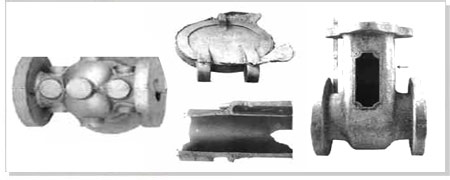- Quantity of the material per casting used in for making molds would be minimized.
- To improve the output, general feeders and system for gating can be utilized.
- Initializing time required for production during the preparation of molds, pouring process, time for processes like shakeout and removing of extra metal per casting is also minimized.
- The costs involved for tooling processes are counterbalanced by the savings indicated as above. In the scenario where size of the castings is very small in reference to the nominal size of manufacturing of the molds but the quantities produced is very large, multiple cavities are preferred.
- It should help to avoid any harm to the mold, and
- It should allow sufficient transfer of the heat so that no hot spots are produced within the casting near to any cavity.
- To identify the type of a mold required in respect to its dimensions inclusive of length, width and height..
- To fix the minimum distance between adjacent cavities and cavity to mold edge.
- To estimate the maximum numbers of cavities that can be accommodate.
- To calculate the ration of metal to sand.
Only after the orientation of castings and parting have been finalized, the cavity of the mold is considered. The shortest distance within the cavities of the mold and from one cavity to the nearest one is always fixed well in advance. This shortest distance must be such that :
This distance within the cavities ranges within 25 mm to 50 mm for small size castings and medium size castings respectively. The quantity of cavities per mold is based on ratio known as metal to sand ratio and its mathematical representation is given as :
þmetal (Nc Vc + Vf + Vg) / ?sand (Vmold - (Nc Vc + Vf + Vg))

Where þmetal represents casting's density
and ?sand is the density of material used in the mold,
Nc stands for the number of cavities in casting,
Vc is for the volume of a particular cavity,
Vf represents the total volume of all the feeders used
Vg is the total volume of gating,
And Vmold is the total volume of mold on the basis of dimensions.
A lower value of metal to sand ratio represents reduced consumption of the material used in mold. A higher ratio of the same leads to poor transfer of heat and thus, it should be avoided. Since, this leads to more defects in respect to the process of solidification of castings. The lowest standard value for the ratio of metal to sand used in ferrous castings is 1:1. However, in practical applications, it lies within the range of 1:2 to 1:6.
There's a defined procedure to find out the finest number of cavities. It is as followed:
The above practice is repeated for various sizes of mold, and the mold having highest value of metal to sand ratio is finalized for further application.
